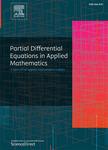版权所有:内蒙古大学图书馆 技术提供:维普资讯• 智图
内蒙古自治区呼和浩特市赛罕区大学西街235号 邮编: 010021

作者机构:Department of Mathematics Dayananda Sagar College of Engineering Karnataka Bengaluru India School of Mechanical Engineering Rayat Bahra University Mohali India Department of Mechanical Engineering School of Engineering and Technology JAIN (Deemed to be University) Karnataka Bangalore India NIMS School of Mechanical & Aerospace Engineering NIMS Institute of Engineering & Technology NIMS University Rajasthan Jaipur India Center for Scientific Research and Entrepreneurship Northern Border University Arar 73213 Saudi Arabia Department of Computer Engineering College of Engineering Knowledge University Erbil 44001 Iraq Department of Computer Engineering Al-Kitab University Altun Kupri Iraq Department of Mathematics and Information Technologies Vice-Rector for Scientific Affairs Tashkent State Pedagogical University Tashkent Uzbekistan Department of Mechanical Engineering College of Engineering Prince Mohammad Bin Fahd University Al-Khobar Saudi Arabia Faculty of Engineering Sohar University Sohar Oman
出 版 物:《Partial Differential Equations in Applied Mathematics》 (Partial Diff. Equ. Appl. Math.)
年 卷 期:2025年第13卷
基 金:Deanship of Scientific Research at Northern Border University (NBU-FFR-2024-2461-XX NBU-FFR-2024-2461-13)
主 题:Convergent/divergent channel FEM Homogeneous-heterogeneous chemical reaction Hybrid nanofluid L-PINN Quadratic thermal radiation
摘 要:Convergent and divergent channels have practical uses in the manufacture of fibres and glass, for the production of plastic sheets, the control of molten metal flows, and casting of metals. Also, hybrid nanofluids are being explored as possible working fluids for solar collectors and other high heat flux systems because of their outstanding heat transfer abilities. The present study focuses on exploring the effect of quadratic thermal radiation on the hybrid nanoliquid stream via a convergent/divergent channel, considering the impact of homogeneous-heterogeneous chemical reactions with the suspension of tantalum and alumina nanoparticles on the liquid stream. The governing partial differential equations of the present problem are transformed into dimensionless ordinary differential equations with the help of similarity variables. Further, the resultant equations are solved using the finite element approach. Also, the Laguerre Polynomial-based Physics Informed Neural Network (L-PINN) model is adopted to analyze the fluid flow, heat, and mass transfer characteristics. The significance of pertinent physical parameters on the field variables is depicted with graphical representations. Turbulence, caused by chaotic fluid motion, increases energy dissipation, which can limit the channel s effective flow velocity in stretching convergent channels. A rise in the Reynolds number in a divergent stretchable and shrinkable channel raises the temperature due to improved convective heat transfer. © 2024